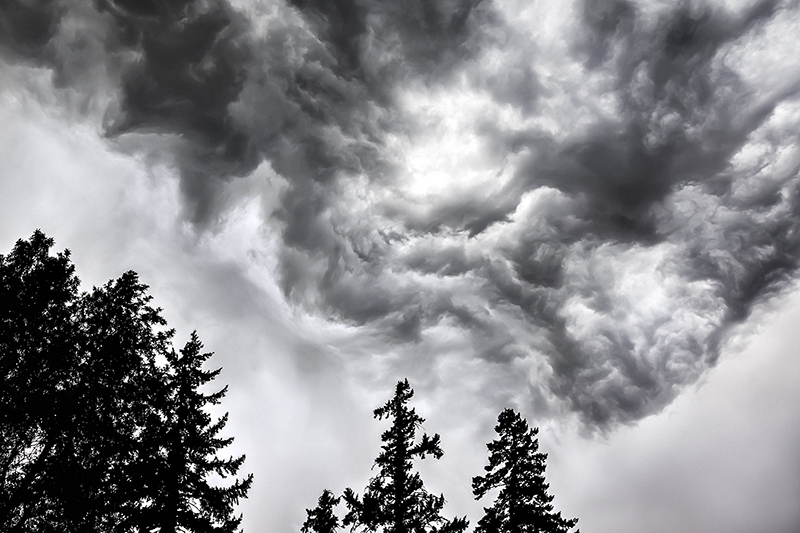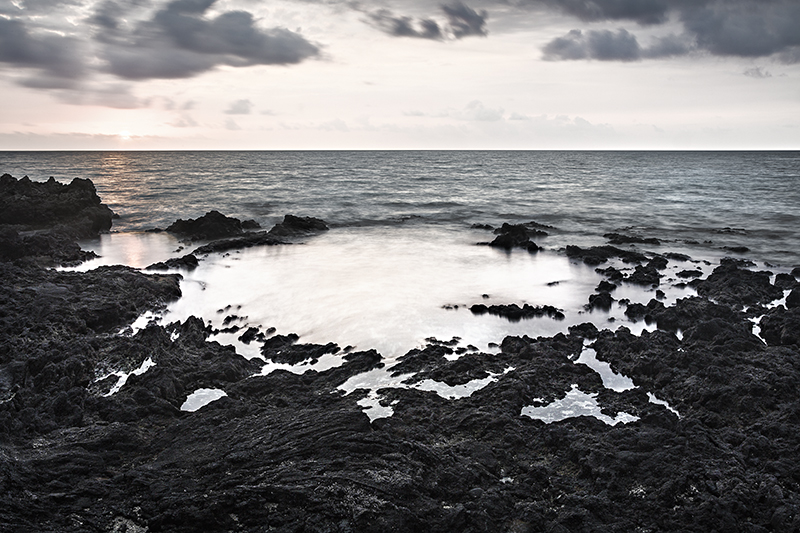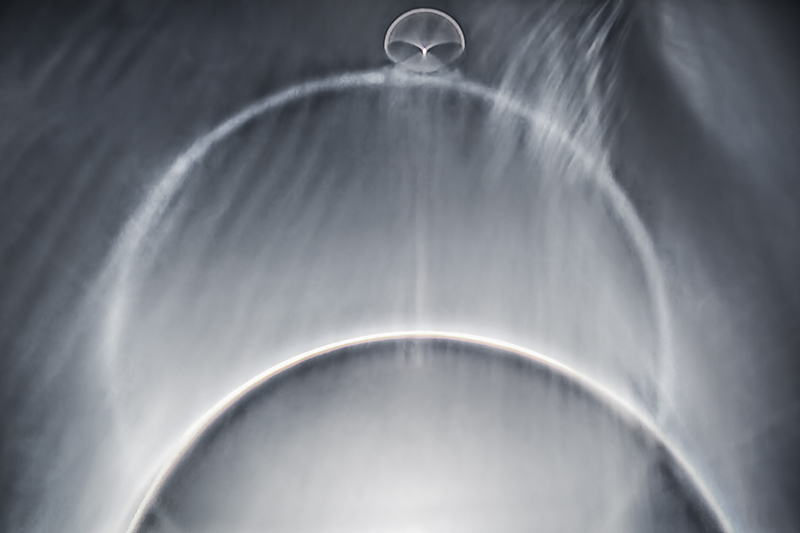Perception Through the Portal:
The photography of William Pierson
"Art is…a projection of an inner image. It is not its proximity to reality that proves its value but its nearness to the artist's psychic life.
--Ernst Kris
"The images in my photographs all become expressions of an ardent desire to journey beyond physical appearances. They have taught me, revealed their truth, unfolded their mystery, and blessed me with a sense of myself and my connection to the universe. The best have put my finger on the pulse of my soul."
--William Pierson
Rocky coastlines, waveforms, clouds, the night sky—these are among the elements that make up the raw material for William Pierson's compelling photographs. But the naturalistic aspect of his work is ancillary. What he captures in his photographs is something beyond the world of objects and vistas. To say he photographs nature is like saying Hopper painted houses—a true, but entirely unsatisfactory statement. Pierson employs the physical realm as a gateway to deeper, more metaphysical explorations.
Pierson speaks of "a desire to journey beyond physical appearances" with his photographs, and looking at his work it is clear that his eye sees more than the external. The object's form may tell us it's a tree, but that simple shape is not necessarily what Pierson is responding to or trying to capture. He is searching for what it is inside himself that makes certain moments resonate. The goal is for the final image to reproduce the feeling he had in the moment the photograph was taken—the intense connection he feels with the universe at that moment in time.
Utilizing a wide range of digital capture approaches, including time exposure, Pierson allows us to see as he sees—or more accurately to see what he feels. He coaxes something entirely other, something intensely personal, from familiar universal components. The otherness in his work often comes in the form of real and imagined elements discovered within the familiar: pathways, portals, voids, dividing lines, symmetry. They are aspects that our eyes, as we rush through our daily lives, would likely miss.
The photographs, by virtue of being external representations of the artist's internal state, function as self-portraits offering the viewer glimpses of Pierson's emotional landscape. Simultaneously, familiar aspects of the natural world become new and surprising to behold. We see a body of water or an expanse of sky with new eyes—with a new sense of possibility and awe.

Pierson's 2014 photograph, "Vortex above the Forest," exemplifies his ability to coax the personal out of the familiar. The photograph depicts a storm-darkened, turbulent sky above silhouetted treetops. It is a dramatic, yet not unfamiliar scene. But the photograph that Pierson creates from this moment goes beyond the scenery's inherent drama to become something other than simply a photograph of a spectacular sky. The aspects that Pierson accentuates through intuitive composition and the nuanced treatment of light and dark spaces take the photograph beyond recorded natural moment and into the realm of psychic self-portraiture.
Beginning in the lower left corner and moving up to the right, the photograph contains three distinct zones: the strong verticals of the silhouetted trees, a band of quieter sky, and the storm's dark vortex swirling around a brilliant center. The interaction of these three zones becomes a manifestation of Pierson's striving for what he describes as "a connection to the universe."
In this photograph, we experience the drama and mystery from an earthly vantage point. The viewer is grounded, along with the photographer and the trees, firmly in the natural realm. The treetops' downward slope draws the eye to the central two trees, their tops bridging the quieter expanse of sky, reaching for the mystery, the bright light, at the center of the vortex. In these two dark forms we can see and feel the artist's own desire to reach beyond the natural to the metaphysical, to bridge the chasm between the two and record what he discovers.

The swirling, bright center in "Vortex above the Forest" is mirrored in another 2014 photograph, "Pool of Tranquility." In this photograph, we see once again a familiar vista transformed under Pierson's gaze into something surprising and ethereal.
The photograph depicts a multidimensional coastal scene incorporating intricate layers and textures: the shoreline's craggy igneous forms, the movement of the sea, the finality of the horizon's laser-line, and even the drama of the setting sun. All this movement and variation is balanced and ordered around the photograph's central image—the pool's bright, mysterious void.
While contextually we know we are looking at a tidal pool, Pierson's treatment makes the pool feel otherworldly. The tonal and textural differences separate the pool from the movement of the ocean and even from the familiar stillness of smaller adjoining pools. In fact, the pool scarcely reads as water at all: It feels neither liquid nor solid. It feels simultaneously full and empty. A viewer may just as easily create a narrative with the pool as a creative force out of which the rest of the scene has somehow emerged, or a destructive force in the process of erasing or consuming the landscape itself.
The pool's bright circular space feels beyond our expectations of the natural world, becoming a gateway to a place where elements no longer follow rules. In "Pool of Tranquility," we can see Pierson balancing the sensory abundance of the natural world against the material emptiness of the metaphysical. It is, in part, his ability to juxtapose the natural and the metaphysical that makes his work compelling.

Some of Pierson's latest work, while certainly still using natural forms and vistas, is becoming increasingly abstract. This movement toward abstraction is perhaps necessary as the artist reaches to capture something as intangible and complex as the connection between his environment, his psyche, and the unknown spaces between and beyond. Abstraction's inherent possibilities, its ability to convey emotion and even place without providing concrete representational cues for either, serve Pierson well. The viewer feels tethered to the images in his abstract work in part because they are born of elements from the familiar, natural world.
In "Double Sphere" (2014), there is an immediate celestial association in the overlapping shapes but subtle shifts in color and texture, as well as Pierson's compositional choices, inspire other connections. The photograph's surface ripples, alive with atmospheric turbulence or, on a more metaphorical plane, something akin to what Pierson describes as, "the vibrations of the universe." By restricting our view of the spheres, by allowing us to see only a portion of each circular outline, we simultaneously feel the sense of interruption and pending completion—although we can't see it, we know the curve continues to complete the perfect circle.
Pierson often incorporates reflection in his work. The doubling in "Double Sphere" invokes the same sensations as the more literal mirroring does in some of his other pieces. The viewer is left with a notion that he or she is witnessing an image from beyond the natural world, on the other side of everyday perception—the expected and the unexpected, the concrete and the abstract, captured in the same instant.
At the most fundamental level, a William Pierson photograph portrays the metaphysical glimpsed through the portal of the physical, natural realm. Regardless of whether the piece is figurative or abstract, what Pierson captures in his photographs are moments when his emotional landscape is mirrored in his surroundings—moments when the internal and external meet and become visible to the artist's eye in a shaft of light, a reflection, or the emptiness of a void.